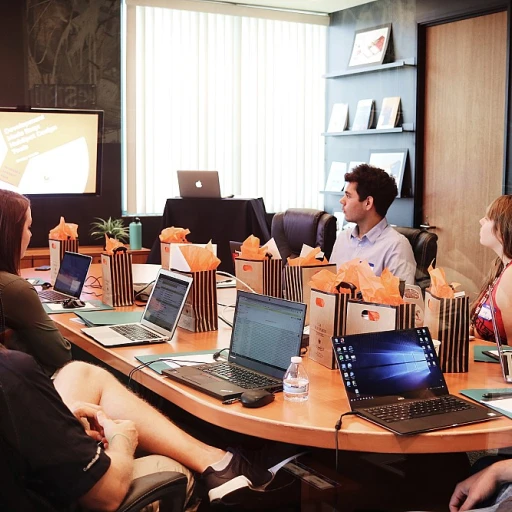
Understanding Succession Planning
The Importance of Succession Planning
Succession planning is a pivotal aspect of any thriving organization. It involves identifying and nurturing individuals who can step into key roles when necessary. This proactive strategy ensures that businesses have competent leaders ready to take the helm, minimizing disruption and maintaining continuity. Effective succession planning is not just about replacing senior executives when they retire or move on. It's about creating a pipeline of talent that supports the organization's long-term vision and goals. By doing so, companies can secure their future and maintain competitive advantage in an ever-evolving marketplace.Fostering a Culture of Leadership
A strong succession plan encourages a culture where leadership development is prioritized. Organizations that cultivate such a culture benefit from increased engagement and retention among their workforce. Employees are likely to stay with a company that invests in their growth, knowing they have the opportunity to progress into leadership roles. Fostering this culture requires commitment from top management as well as a transparent process that identifies potential leaders early in their careers. Investing in training and development is key to equipping future leaders with the skills they need to succeed.Building a Framework
As you embark on the journey of preparing successors for leadership, it's vital to have a structured approach in place. Developing a comprehensive framework can guide your organization through each stage of the succession planning process. This framework should include clear objectives, timelines, and evaluation metrics to monitor the effectiveness of your plan. Establishing well-defined criteria for assessing potential successors will enable you to identify the most suitable candidates for leadership roles. Additionally, consider involving various stakeholders in the planning process, including current leaders, HR professionals, and even external consultants if necessary. This collaborative approach can provide diverse perspectives and enrich the development of the succession plan. To learn more about building a roadmap for future leaders, check out this insightful resource: building a roadmap for future leaders.Identifying Potential Successors
Spotting Leadership Potential Within Your Team
Identifying potential successors is a crucial phase in preparing future leaders. It involves recognizing employees who not only possess relevant skills but also demonstrate the capability to evolve into effective leaders. This process requires a keen understanding of what makes a strong leader and the ability to observe these qualities in action.
- Performance and Results: A potential successor should already be delivering strong performance in their current role. This demonstrates that they have both the competence and the work ethic necessary for higher responsibilities.
- Leadership Qualities: Look for individuals who naturally take initiative, display problem-solving abilities, and possess strong interpersonal skills. These traits suggest a readiness to transition into leadership roles.
- Eagerness to Learn: Those who are consistently seeking to improve and learn new skills are often the most adaptable and forward-thinking, qualities essential for future leaders.
- Adaptability: In today's rapidly changing business environment, the ability to adapt to new challenges and innovate is invaluable. Those who embrace change positively can often make great leaders.
- Feedback Receptivity: Evaluate how well potential successors accept and act on feedback. This reflects their openness to growth and personal development.
While identifying potential leaders, it's important to ensure diversity and inclusivity in the selection process. A diverse leadership team can offer a wide range of perspectives and drive creativity within the organization. For a structured approach to developing your next set of leaders, consider building a roadmap for future leaders.
Creating Development Plans
Crafting Effective Development Plans
An essential part of preparing your future leaders is creating tailored development plans. These plans act as a roadmap, identifying specific areas where potential successors need growth to fill leadership roles effectively. By focusing on individual needs and organizational goals, development plans ensure a smooth transition in leadership while also boosting talent retention.Personalized Learning Paths
To maximize the potential of your future leaders, consider designing personalized learning paths that cater to each individual's strengths and weaknesses. This can include a mix of:- Mentorship and coaching sessions with current leaders
- Training workshops or seminars
- On-the-job project assignments to build experience
Tracking Progress and Providing Feedback
Ongoing evaluation and feedback are critical components of development plans. Establish regular check-ins to monitor progress and offer constructive feedback to guide potential successors through their development stages. Encourage them to set short-term and long-term goals that align with both their career aspirations and the company’s strategic objectives.Integrating Cross-Functional Experience
A well-rounded leader should have cross-functional experience that enables a broader organizational perspective. To achieve this, incorporate opportunities that allow successors to work in different departments or roles. This exposure can help them understand the organization’s operations more comprehensively and foster collaboration across teams. To further explore how mastering talent management can contribute to your organization's future success, consider visiting Mastering Talent Management for Future Success. Crafting effective development plans is crucial for preparing capable and confident leaders. By focusing on personalized growth paths, continuous feedback, and diverse experiences, organizations can ensure the future of their leadership is in capable hands.Implementing the Succession Planning Process
Steps to Execute an Effective Transition Plan
The implementation of a succession planning process is a critical phase where theoretical plans are transformed into actionable steps. This step-by-step guide ensures a smooth transition and addresses potential challenges.- Initiate with Clear Communication: It’s essential to communicate the succession planning process clearly to all stakeholders. Ensuring transparency helps diminish any uncertainties, encourages engagement, and aligns everyone with the common goal.
- Set Practical Timelines: Clearly outline the timelines for the transition. A well-planned timeline guarantees adequate time for successors to acclimate to their upcoming roles. It also allows for any necessary adjustments along the way.
- Assign Mentorship Roles: Pair successors with experienced leaders within the organization. Mentorship provides invaluable insights and serves as a bridge between theoretical knowledge and real-world application.
- Establish Milestones: Break down the development plan into smaller, achievable milestones. Each milestone serves as a checkpoint to assess progress and make necessary adjustments to the succession strategy.
- Conduct Regular Reviews: Set up periodic reviews to assess the progress of your successors. These reviews provide an opportunity to address any gaps in skills or knowledge, and to refine the development strategy to better fit organizational needs.
- Use a Feedback Loop: Encourage a culture of feedback between mentors, supervisors, and successors. Constructive feedback is instrumental in personal and professional growth, and plays a crucial role in refining leadership qualities.
- Monitor and Adjust the Process: Succession planning is an evolving process. Regular monitoring and evaluating its effectiveness is key. Adjustments should be made based on the organization’s changing needs and the performance of the successors.
Case Studies and Real-World Examples
Real-Life Applications and Insights
When preparing successors for leadership, it's crucial to look at how organizations have successfully implemented succession planning strategies. By examining real-world examples, we gain valuable insights to guide our own strategies. Here, we highlight a few notable case studies that demonstrate effective leadership preparation.Tech Giant's Approach: Structured Mentorship Program
A well-known tech giant has developed a structured mentorship program aimed at nurturing high-potential employees. Through their mentorship initiative, senior leaders actively guide potential successors, providing them with critical industry knowledge. This hands-on approach facilitates learning through experience, helping successors to develop the skills needed for future leadership roles.Financial Firm's Leadership Rotation
A successful financial company implemented a leadership rotation program as part of its succession planning approach. By assigning rising stars to temporary leadership positions across various departments, the firm exposed future leaders to diverse challenges and fostered adaptability. This creative method ensures potential successors gain broad experience and insight into the company's operations.Healthcare Organization's Talent Development Workshops
Another example can be seen in the healthcare sector, where a leading organization conducts regular talent development workshops. These workshops focus on strategic thinking, decision-making, and interpersonal communication—all vital competencies for leadership roles. Attendees engage in group exercises and simulations that reflect real-world scenarios, reinforcing their problem-solving skills.Insights Gleaned from Real Implementations
These case studies demonstrate a shared commitment to fostering the growth of future leaders through tailored programs that emphasize experiential learning and skill development. Key takeaways from these examples include:- Engagement of current leaders in mentoring programs to facilitate knowledge transfer.
- The value of cross-departmental exposure to equip successors with a comprehensive understanding of the business.
- Importance of immersive, real-world scenarios in skill-building workshops.





